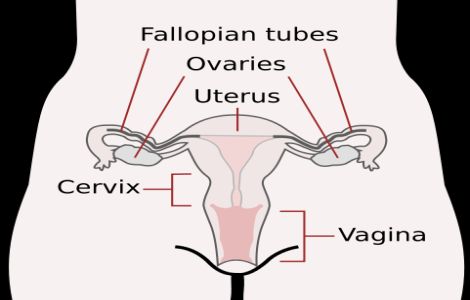Female Genital Tract
Sperm transport in the female reproductive system
The female genital tract is composed of the vagina, cervix, uterus and oviducts. Sperm passage in the female reproductive tract is highly regulated in order to increase the chances of fertilization.
The Vagina
The vagina is a tubular structure that spans the distance between the opening and the cervix. Its surface is covered by muscular, ridged sheath connecting the external genitals to the uterus, where the embryo grows into a fetus during pregnancy. The vagina is the site of sperm disposition during coitus.
The Cervix
The cervix is composed largly of connective tissue. The cervix is lined with cervical mucus, the quality and quantity of which is governed by monthly fluctuations in the levels estrogen and progesterone. When estrogen levels are low, the mucus tends to be thick and sparse, which makes it difficult for sperm to reach the oviducts. But when an egg is ready for fertilization and estrogen levels are high the mucus then becomes thin and slippery, offering a much more friendly environment to sperm. Of the successful sperm that penetrate the cervical mucus, only one-tenth reach the uterus.
The uterus
The In the uterus, sperm are driven towards the small opening of the oviducts -the uterotubal junction by peristaltic contractions of uterine smooth muscles. Of the sperm that reach the uterus, only about one-tenth will reach the oviduct as the uterotubal junction provides another sperm barrier ensuring that only active sperm enter the oviduct.
The oviduct
Only mature sperm are able to reach the oviduct due to the various defensive mechanisms present in the female genital tract. The oviduct is composed of three regions; isthmus, ampulla and infundibulum. It is believed that sperm enter the isthmus and bind to the oviductal epithelium forming a reservoir. This reservoir is called the isthmatic sperm reservoir. Only mature sperm are able to reach the oviduct due to the various defensive mechanisms present in the female genital tract The oviduct is composed of three regions; isthmus, ampulla iand nfundibulum. It is believed that sperm enter the isthmus and bind to the oviductal epithelium forming a reservoir This reservoir is called the isthmatic sperm reservoir.

Image courtesy of: https://commons.wikimedia.org/wiki/File:Scheme_female_reproductive_system-en.svg Public domain image.
Sperm Reservoir
The sperm reservoir maintains sperm viability and suppresses sperm movement in order to correlate sperm maturation with ovulation. The sperm reservoir increases the chance of fertilization as it prolongs the availability of sperm in the oviduct. In the isthmus region of the oviduct, sperm undergo an important maturation stage in which they loose their protective coat enabling them to bind to the zona pellucida, undergo the acrosome reaction and fuse with the oocyte. This maturation phase is termed capacitation and lasts for 5-6 hours in humans. It has been shown that mammalian sperm are unable to fertilize the oocyte before capacitation. At ovulation, the oocyte is released and propelled to the ampulla region of the oviduct by oviductal contractions. Fertilization occurs in the ampulla region of the oviduct.
